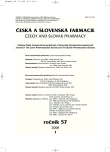Hemostatic effects of oxidized cellulose
Authors:
P. Kollár 1; P. Suchý 1; J. Muselík 2; Marika Bajerová 2; P. Havelka 3; T. Sopuch 4
Authors‘ workplace:
Veterinární a farmaceutická univerzita Brno, Farmaceutická fakulta, Ústav humánní farmakologie a toxikologie
1; Veterinární a farmaceutická univerzita Brno, Farmaceutická fakulta, Ústav technologie léků
2; Výzkumný ústav organických syntéz a. s., Pardubice
3; Synthesia, a. s., Pardubice – Semtín
4
Published in:
Čes. slov. Farm., 2008; 57, 11-16
Category:
Review Articles
Overview
Oxidized cellulose ranks among nontoxic and biocompatible biopolymers. Oxidized regenerated cellulose (ORC) is manufactured from regenerated cellulose derived from wood pulp containing about 50% of cellulose. To obtain purified cellulose, it is necessary to decompose it in a chemical way and subsequently put it together to make “regenerated” cellulose. Thanks to its good hemostatic effects, high biosolubility and biodegradability, antioxidant and wound-healing properties, oxidized cellulose represents a suitable means for the therapy of bleeding conditions in various fields of medicine. In addition, the confirmed bactericidal effects of oxidized cellulose towards a wide spectrum of aerobic and anaerobic pathogens increase the therapeutic potential of this agent for use in clinical practice. At present there is a renewed interest in its wider use in clinical practice and in an improvement of the knowledge of its mechanisms of effects, which are tested in vitro, on animal models as well as in clinical studies. The present paper attempts to summarize the hitherto knowledge of hemostatic properties of oxidized cellulose and also to characterize other possible biological effects.
Key words:
oxidized cellulose – ORC – hemostatic agent – bleeding
Sources
1. Wagner, W. R., Pachence, J. M., Ristich, J. et al.: J. Surg. Res., 1996; 66, 100–108.
2. Schonauer, C., Tessitore, E., Barbagallo, G. et al.: Eur. Spine J., 2004; 13 (Suppl. 1), S89–S96.
3. Raccuia, J. S., Simonian, G., Dardik, M. et al.: Am. J. Surg., 1992; 2, 234–238.
4. Oto, A., Remer, E. M., O’Malley, C. M. et al.: Am. J. Roentgenol., 1999; 6, 1481–4148.
5. Levy, M. L., Day D. J., Fukushima, T.: Neurosurgery, 1997; 41, 701–702.
6. Voormolen, J. H., Ringers, J., Bots, G. T. et al.: Neurosurgery, 1997; 20, 702–709.
7. Dimitrijevich, S. D., Tatarko, M., Gracy, R. W.: Carbohydr. Res., 1990; 2, 247–256.
8. Dimitrijevich, S. D., Tatarko, M., Gracy, R. W. et al.: Carbohydr. Res., 1990; 2, 331–341.
9. Achauer, B. M., Black, K.S., Grosmark, D.M. et al.: J. Microsurg., 1982; 3, 242–247.
10. Mášová, L., Ryšavá, J., Křížová, P. et al.: Sb. Lek., 2003; 2, 231–236.
11. Ryšavá, J., Mášová, L., Dyr, J. et al.: Čas. Lék. čes., 2002; 141, 50–53.
12. Stiluehll, R., Uitmor, I., Sehjferstejn, E.: RF Patent No. 2136319 (1999); Byull. Izobret., 1999; 25.
13. Kothbauer, K., Jallo, G., Siffert, J. et al.: J. Neurosurg., 2001; 3, 503–506.
14. Sharma, J., Malhotra, M., Pundir, P.: Int. J. Gynaec. Obstet., 2003; 3, 271–275.
15. Belozerskaya, G. G., Makarov, V. A., Zhidkov, E. A. et al.: Pharm. Chem. J., 2006; 7, 353–359.
16. Daurova, T. T., Andreev, S. D.: Klin. Khirurg. 1981; 1, 5–7.
17. Taniguchi, K., Kohno, I., Tanabe, R. et al.: Eur. Patent No. 1269951 A1 (2001).
18. Pendharkar, S. M.: Eur. Patent No. 1424085 A1 (2004).
19. Guo, J., Looney, D., Zhang, G. et al.: Eur. Patent No. 1378255 A2 (2003).
20. Ryšavá, J., Dyr, J. E., Homola, J. et al.: Sensors and Actuators B: Chemical, 2003; 1, 243–249.
21. Křížová, P., Mášová, L., Suttnar, J. et al.: J. Biomed. Mater. Res. A., 2007; 2, 274–280.
22. Gago, L. A., Saed, G., Elhammady, E. et al.: Fertil Steril., 2006; 86 (Suppl 4), 1223–1227.
23. Kanko, M., Liman, T., Topcu, S.: J. Invest. Surg., 2006; 5, 323–327.
24. El-Assmy, A., Eassa, W., El-Hamid, M. A. et al.: BJU Int., 2007; 5, 1098–1102.
25. Finn, M. D., Schow, S. R., Schneiderman, E. D.: J. Oral. Maxillofac. Surg., 1992; 6, 608–612.
26. Brodbelt, A. R., Miles, J. B., Foy, P. M. et al.: Ann. R. Coll. Surg. Engl., 2002; 2, 97–99.
27. Cherian, R. A., Haq, N.: Ind. J. Radiol. Imag., 1999; 2, 49–51.
28. Iwabuchi, S., Koike, K., Okabe, T. et al.: Surg. Today, 1997; 10, 969–970.
29. Sandhu, G. S., Elexpuru-Camiruaga, J. A., Buckley, S.: Br. J. Neurosurg., 1996; 6, 617–619.
30. Schönfelder, U., Abel, M., Wiegand, C. et al.: Biomaterials. 2005; 33, 6664–6673.
31. Scher, K. S., Coil, J. A. Jr.: Surgery, 1992; 3, 301–304.
32. Spangler, D., Rothenburger, S., Nguyen, K. et al.: Surg. Infect. (Larchmt.), 2003; 3, 255–262.
33. Kakagia, D. D., Kazakos, K. J., Xarchas, K. C. et al.: J. Diabetes Complications, 2007; 6, 387–391.
34. Hollister, C., Li, V. W.: Nurs. Clin. North. Am., 2007; 3, 457–465.
35. Uysal, A. C., Alagoz, M. S., Orbay, H. et al.: Ann. Plast. Surg., 2006; 1, 60–64.
Labels
Pharmacy Clinical pharmacologyArticle was published in
Czech and Slovak Pharmacy

2008 Issue 1
Most read in this issue
- Signal pathways of cell proliferation and death as targets of potential chemotherapeutics
- Hemostatic effects of oxidized cellulose
- Substances Modifying the Activity of Caspases
- Antioxidant activity of tinctures prepared from hawthorn fruits and motherwort herb
